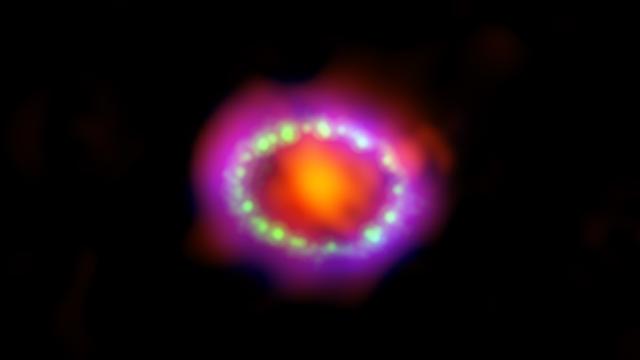Perhaps the most important supernova of the modern era is SN 1987A, the closest supernova to Earth since the invention of the telescope. Scientists have been observing the explosion’s remnants since the 1987 event.
Scientists led by University of Toronto graduate student Yvette Cendes have presented a new report showing the 25 years of radio wave observations of the stellar corpse’s evolution from 1992 to 2017. You can watch those observations in the time-lapse below.
The GIF shows the radio flux after a star at the end of its lifespan collapsed in on itself, ejecting matter and energy. Fewer radio waves are depicted in blue, more radio waves in red, and the most in white. We’ll get to what’s emitting those waves in a bit.
SN 1987A was the closest supernova to the Earth since “Kepler’s supernova,” which was observed worldwide in 1604. It occurred 168,000 light-years away in the Large Magellanic Cloud, and its remnants have been extensively studied as a way to understand what happens after a star dies and how supernovae evolve. It was also the first example of “multimessenger astronomy,” in which scientists detect both light as well as other particles emitted, since it came with a few detectable neutrino particles.
Scientists took these images of the remnants’ radio waves using the Australia Telescope Compact Array, and published them yesterday in the Astrophysical Journal. Their observations show that the remnants of the supernova continue to expand, and have more recently have begun to fade in the southeastern portion. Additionally, they observed that its expansion has sped up in the past three years.
You’ll notice the ring shape in the early images — this is material ejected by the star prior to the supernova. The supernova’s shock wave passed by the ring, causing electrons to spiral from changes to the magnetic field and release photons.
The scientists behind the new paper think the accelerated expansion could be a sign that the shockwave is beginning to leave the ring, which would explain the dimming on the southeastern portion.
“The reason it’s more interesting now is that it looks like the shockwave plowed through this dense material in the ring surrounding the supernova and has now re-accelerated as it goes into a less-dense medium,” said Cendes. “That’s very cool, classic shock wave physics.”
This isn’t the only telescope or large dataset observing the behaviour — Hubble, the Chandra X-Ray Telescope, and plenty of others check in on this supernova periodically to see how things are going. Other observations in other wavelengths of light confirm the observations presented here.
It’s not often you get to see an astronomical event occurring in real time (well, with a delay of 168,000 years, but you know what I mean). And you can bet that scientists will continue studying the crap out of this supernova to try and understand these chaotic events more generally.
[ApJ]
